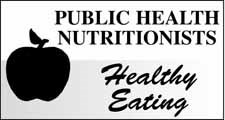Many commercials try to persuade us to buy food. Some suggest that a certain food will make us feel good or that acting a certain way gets a food reward. What are advertisers selling and what effect does it have on children?
Advertisers use media to get their message out to the public. TV is the main way to reach young children, especially children 2-11 years of age. Children see three times more commercials today than in the 1970's. At least half of those commercials are for food and are shown during children's programs. Young children watch about 21 food commercials a day. This does not include print, radio, internet, video games or other media!
Children are an important target group for marketers. Children have purchasing power now, because they influence parent's buying decisions, and as a future adult. Marketers easily persuade children, who do not yet have a sense of want vs need, with music, toys and contests. Food commercial claims are not technically false but can confuse children and parents about what makes a food healthy.
Most foods marketed to children are high in fat, sugar and salt, and low in fibre and other healthy nutrients. About 80% of foods intended for children are fast foods, sweets, and cereal. Breakfast cereals aimed at children have 85% more sugar and 65% less fibre than cereal products aimed at adults. Since TV advertising of less healthy foods is linked to obesity, these ads put children's health at risk.
Commercials link food with fun, play, being popular, sports, and happiness with little mention of actual product content. Messages often imply that a food can lift your mood or tastes so good you cannot live without it. Children see people that trick, fight and lie to obtain food. What can you do to be a savvy consumer and teach children to be savvy now and in the future?
Talk about the purpose of advertisingAsk why a product is a "must-have"Encourage children to challenge advertisers' claimsWatch commercial free TV or better yet, limit TV timeBe a role model for eating habits and behaviour Don't feel guilty for not buying the commercials' foodsEven though TV may influence what a child wants, parents are still the most important factor for setting the family diet. Parents have control whether the item purchased is the healthy choice. Look at the Nutrition Facts table to compare nutrients and select the best option. For example, a serving of breakfast cereal should have:Sodium - 480 mg or less (20% Daily Value)Fibre - 2 g is okay, 4 g is better, 6 or more is excellentSugars - 12 g or less
Healthy Foods for My School (www.health.
gov.sk.ca/healthy-foods-for-my-school) is a valuable tool for using food labels to select healthy packaged foods.
Written by the Public Health Nutritionists of Saskatchewan and supported by Public Health, Sunrise Health Region.
If you have any comments or questions please contact: Heather Torrie, Public Health Nutritionist, Sunrise Health Region, 150 Independent Street, Yorkton, Sask. S3N 0S7 or phone: 786-0600.




